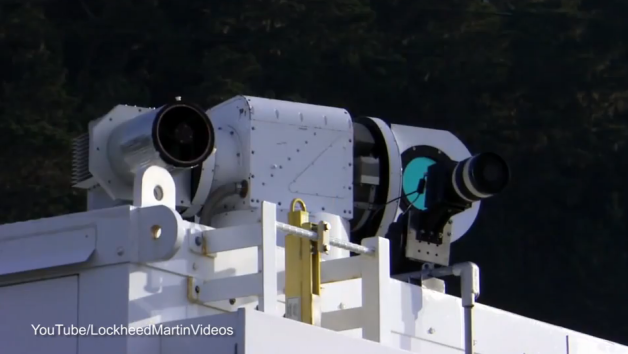
ATHENA (Advanced Test High Energy Asset), is the offspring of ADAM (Area Defense Anti-Munitions).
Fiber-optic lasers are revolutionizing directed energy systems according to Lockheed Martin.

BYPASS THE CENSORS
Sign up to get unfiltered news delivered straight to your inbox.
You can unsubscribe any time. By subscribing you agree to our Terms of Use
Latest Video
See Video Below
The new laser system is capable of taking out a truck by burning a hole in its manifold; Demonstrated in the tests carried out by the team from Lockheed, positioned over a mile away from the truck.
During a marine test the high-energy laser demonstrably burnt a hole, through multiple compartments of the rubber hull of a military-grade small boat, in less than 30 seconds.

A spokesman for the company said “This test represents the next step to providing lightweight and rugged laser weapon systems for military aircraft, helicopters, ships and trucks”.”we are investing in every component of the system – from the optics and beam control to the laser itself – to drive size, weight and power efficiencies”.
Keoki Jackson, Lockheed Martin’s chief technology officer said : ‘This 30-kilowatt milestone shows our commitment to producing the high beam quality and high power needed to address a variety of military ‘speed-of-light’ defensive operations.’
Senior fellow Rob Afzal told breakingdefense.com on the subject of HELMD ( High Energy Laser Mobile Demonstrator ), “We believe that system itself can go to 100,” he told reporters in February. “We think that, with today’s technology, fiber lasers will scale to 300, arguably beyond 300.” With future improvements in the underlying laser technologies, he said, “we think we can get well beyond 500 kw.”
Under current plans, Afzal said, “we’re dollar-limited to a 100 or 150 kw. We’re not technology-limited. And we’re probably about two to three years from being able to go to 300 [kw] if funding is supplied.”
“We can build 100-kw class systems today [that] can go onto LCS [the Navy Littoral Combat Ship],” Afzal said. (100 kw is enough to kill cruise missiles at short ranges or drones at long ranges, according to the Center for Strategic and Budgetary Assessments). “It can go onto Army trucks,” he continued. “We can go into large aircraft. We’re probably not ready for fighter aircraft today.”
At 30 to 35 percent efficiency — the current cutting edge with fiber-optic lasers — 300 kw of output would require just under a megawatt of electrical power. By contrast, older laser technologies managed about 10 percent efficiency, so that same megawatt of electricity would only get you 100 kilowatts of laser power, with the other 900 kw coming out as waste heat. You could build big lasers for experiments, but the power and cooling requirements were untenable for any tactical use.
The big difference today is small fiber lasers. Each fiber individually generates at most 10 kw, but you can combine their beams to get greater power output. Yet you can still cool each fiber individually, which prevents the overheating problems that bedeviled older lasers. (As an object grows hotter, the difficulty of getting rid of that heat increases exponentially).
These aren’t the first laser systems to track and destroy targets but Lockheed Martin said its tests are significant because the lasers are smaller, use less power and are more efficient.
Read more..dailymail.co.uk
By using a technique known as spectral beam combining, the system blends multiple laser modules to create a single, powerful, high-quality beam. This is said to provide greater ‘efficiency and lethality’ than multiple individual 10-kilowatt lasers used in other systems. Athena is based on the firm’s Area Defense Anti-Munitions (Adam) laser weapon system. In tests off the California coast in May, Adam was used to successfully disable two boats at a range of approximately one mile (1.6km).
Lockheed Martin said at the time that it developed the ground-based system ‘to demonstrate a practical, affordable defence against short-range threats.’ During the marine the high-energy laser burnt through multiple compartments of the rubber hull of the military-grade small boats in less than 30 seconds.And Lockheed Martin has previously demonstrated the system’s capabilities on airborne targets in flight, including small-calibre rockets and an unmanned aerial system. It can precisely track moving targets at a range of more than 3.1 miles (5km).
‘Our Adam system tests have shown that high-energy lasers are ready to begin addressing critical defense needs,’ added Tory Bruno, president of Strategic and Missile Defense Systems, Lockheed Martin Space Systems Company.


